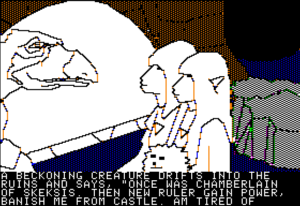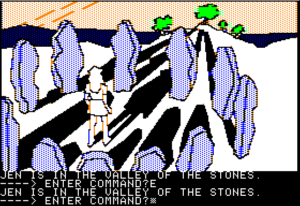The Dark Crystal: Plot and Characters
 I’ve reached the point in the story where Kira, the female lead, shows up. This makes all of the background illustrations different. They could have generalized the problem of adding another gelfling to all the pictures by overlaying an unvarying image of Kira on the same images, like they do with dropped objects. But they chose not to, and it’s probably a good thing. Unless the room graphics are very uniform in layout — which they’re not in this game — that approach frequently winds up displaying things floating in the air or in the middle of a river or something. I wonder again if the experiences gained in making this game led to King’s Quest, with its uniform perspective and sprite-based engine.
I’ve reached the point in the story where Kira, the female lead, shows up. This makes all of the background illustrations different. They could have generalized the problem of adding another gelfling to all the pictures by overlaying an unvarying image of Kira on the same images, like they do with dropped objects. But they chose not to, and it’s probably a good thing. Unless the room graphics are very uniform in layout — which they’re not in this game — that approach frequently winds up displaying things floating in the air or in the middle of a river or something. I wonder again if the experiences gained in making this game led to King’s Quest, with its uniform perspective and sprite-based engine.
Kira’s presence causes the landstriders, which have been present in one room thoughout the game, to suddenly become ridable, something I don’t think I’d have guessed without knowledge of the movie. The Dark Crystal follows the movie pretty closely. It inserts puzzles into the movie’s framework — for example, you have to solve a puzzle to find the double flute that Jen was playing in the movie’s first shot of him — but a significant amount of the game consists of simply replicating Jen’s actions from the movie. The whole thing would probably be bewildering to someone who hadn’t seen the original, but that’s really to be expected. It’s a rare adaptation that really stands on its own. But here, we have the additional handicap of lacking one crucial piece of the game designer’s art, one that hadn’t really been developed yet at this early juncture: cut scenes.
Yes, cut scenes. Strange to think that there was a time before them, seeing what a simple idea they really are, but it wasn’t until the mid-to-late 1980s that they started showing up to any significant degree. It just wasn’t part of people’s idea of how games worked. And without some means of showing things that aren’t happening to the player character, this game has to leave out everything that goes on in the Skeksis castle before Jen gets there. That’s a big chunk of the plot. Instead, the Chamberlain, a major character in the film, just shows up in Jen’s path with no precedent or explanation, and disappears shortly thereafter.
 Comments(2)
Comments(2)